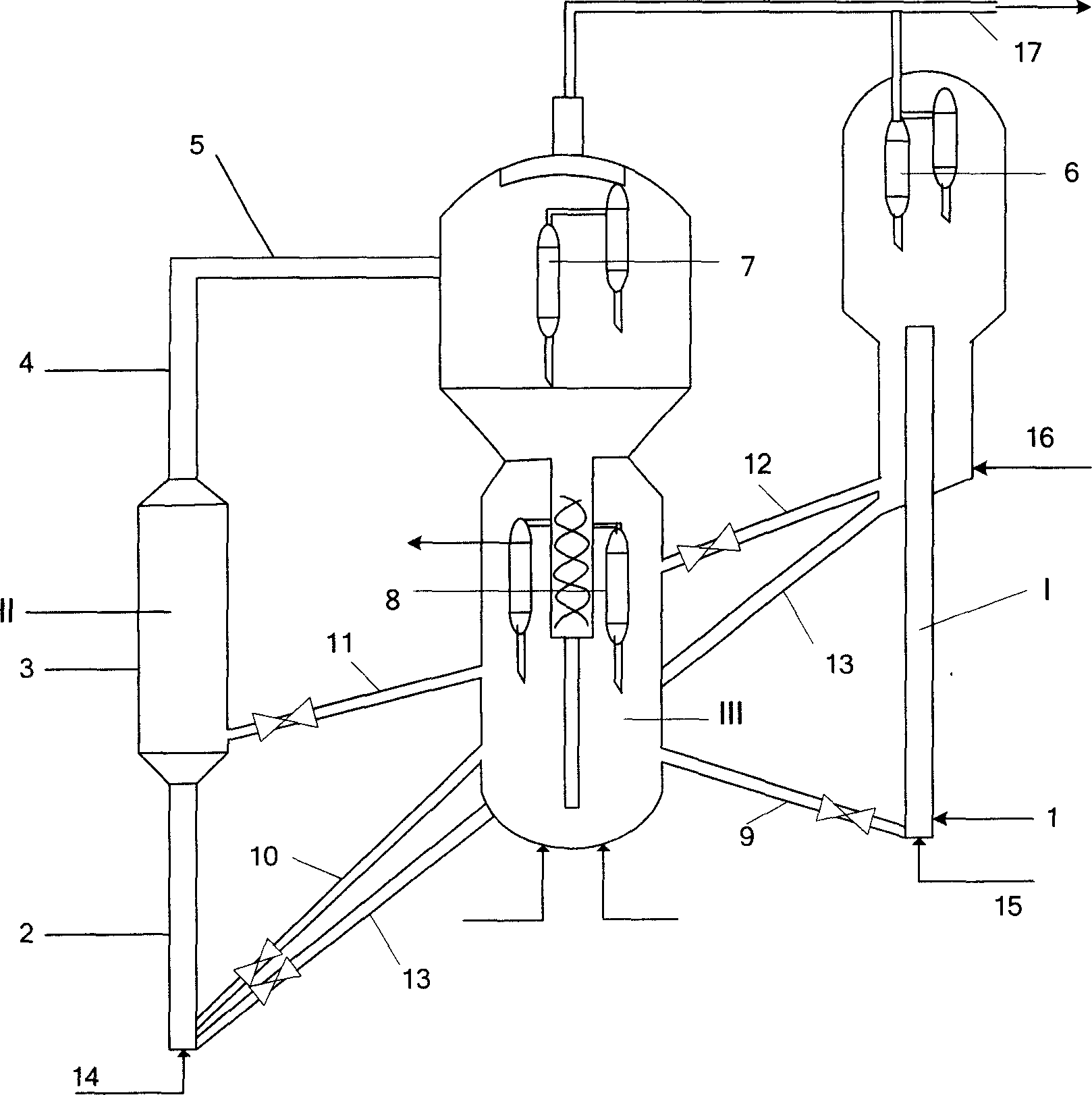Catalytic conversion method capable of increasing propylene yield
A catalytic conversion method, propylene technology, applied in the direction of organic chemistry, bulk chemical production, only multi-stage series refining and cracking process treatment, etc., can solve the problems of increasing the limitation of propylene selectivity and yield of catalytic cracking unit
- Summary
- Abstract
- Description
- Claims
- Application Information
AI Technical Summary
Problems solved by technology
Method used
Image
Examples
Embodiment 1
[0075] Phosphoric aluminum sol preparation: 1.05 kilograms of pseudo-boehmite (dry basis) and 3.35 kilograms of decationized water were beaten for 30 minutes, and 4.9 kilograms of concentrated phosphoric acid (chemically pure, containing 85% by weight of phosphoric acid) were added to the slurry under stirring, and the temperature was raised to 70°C, and then reacted at this temperature for 45 minutes to produce a colorless and transparent phosphoraluminum sol. where P 2 o 5 30.6 wt%, Al 2 o 3 10.5% by weight, pH 1.7.
[0076] Take 2.00 kg (dry basis) F 1 , 1.15 kg (dry basis) of kaolin and 0.65 kg (dry basis) of pseudoboehmite, add 6.2 kg of deionized water and 2.79 kg of aluminum sol for beating for 120 minutes, add 1 liter of FeCl under stirring 3 .6H 2 Aqueous solution of O (which contains 100 g of Fe 2 o 3 ), the pH value of the slurry is 3.0. Continue beating the mixture for 45 minutes, and then add 1.22 kg of phosphorus-aluminum sol to the mixed slurry. After...
Embodiment 2
[0078] Take 1.84 kg (dry basis) F 2 Zeolite, 1.33 kg (dry basis) of kaolin and 0.98 kg (dry basis) of pseudoboehmite, add 7.2 kg of deionized water and 2.79 kg of aluminum sol for beating for 120 minutes, add 1 liter of FeCl under stirring 3 .6H 2 Aqueous solution of O (which contains 250 g of Fe 2 o 3 ), the pH value of the slurry is 3.0. The mixture was further beaten for 45 minutes, and then the resulting slurry was spray-dried at an inlet temperature of 500° C. and an exhaust gas temperature of 180° C. to obtain microspheres with an average particle diameter of 65 μm. The microspheres were calcined at 500°C for 1 hour to obtain 36.8 wt% F 2 Zeolite, 26.6 wt% kaolin, 31.6 wt% Al 2 o 3 and 5.0 wt% Fe additive (as Fe 2 o 3 count) microspheres.
[0079] Take 1 kg (dry basis) of the microsphere product, add 10 liters of decationized water and 100 grams of diammonium hydrogen phosphate, heat up to 60°C under stirring, react at this temperature for 20 minutes, filter the...
Embodiment 3
[0081] Take 2.63 kg (dry basis) F 3 and 1.24 kg (dry basis) of pseudo-boehmite, add 7.2 kg of decationized water and 2.79 kg of aluminum sol for beating for 120 minutes, add 1 liter of FeCl under stirring 3 .6H 2 Aqueous solution of O (which contains 526.5 g of Fe 2 o 3 ), the pH value of the slurry is 3.0. The mixture was further beaten for 45 minutes, and then the resulting slurry was spray-dried at an inlet temperature of 500° C. and an exhaust gas temperature of 180° C. to obtain microspheres with an average particle diameter of 65 μm. The microspheres were calcined at 500°C for 1 hour to obtain 52.63 wt% F 3 , 36.84 wt% Al 2 o 3 and 10.53 wt% Fe additive (as Fe 2 o 3 count) microspheres.
[0082] Take 1 kg (dry basis) of the microsphere product, add 10 liters of decationized water and 105 grams of diammonium hydrogen phosphate, heat up to 60° C. under stirring, react at this temperature for 20 minutes, vacuum filter the slurry, dry, and then Calcined at 500°C fo...
PUM
| Property | Measurement | Unit |
|---|---|---|
| diameter | aaaaa | aaaaa |
| research octane number | aaaaa | aaaaa |
| motor octane number | aaaaa | aaaaa |
Abstract
Description
Claims
Application Information
 Login to View More
Login to View More - R&D
- Intellectual Property
- Life Sciences
- Materials
- Tech Scout
- Unparalleled Data Quality
- Higher Quality Content
- 60% Fewer Hallucinations
Browse by: Latest US Patents, China's latest patents, Technical Efficacy Thesaurus, Application Domain, Technology Topic, Popular Technical Reports.
© 2025 PatSnap. All rights reserved.Legal|Privacy policy|Modern Slavery Act Transparency Statement|Sitemap|About US| Contact US: help@patsnap.com

